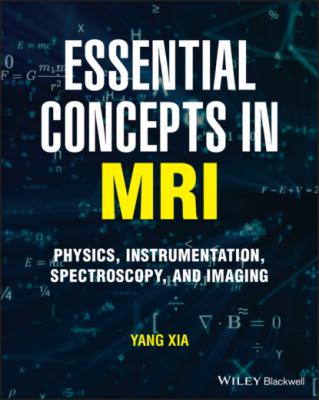ТОП просматриваемых книг сайта:
Essential Concepts in MRI. Yang Xia
Читать онлайн.Название Essential Concepts in MRI
Год выпуска 0
isbn 9781119798248
Автор произведения Yang Xia
Жанр Медицина
Издательство John Wiley & Sons Limited
Figure 2.14 (a) and (b) The time-domain NMR signal in the transverse plane (the FID) is complex and contains real and imaginary components. By the way of Fourier transform, the time-domain NMR signal can be represented by the equivalent signals in the frequency domain, as the absorption and dispersion components, shown in (c) and (d). The peak shift f0 in the frequency domain corresponds to the oscillation of the FID in the time domain. The recovery of the longitudinal magnetization is shown in (e). As noted in Figure 2.10, since T2 is commonly much shorter than T1, the transverse magnetization in (a) and (b) should decay to zero long before the longitudinal magnetization (e) returns to its thermal equilibrium [i.e., the time scales in (a) and (b) are comparable but are different from the time scale in (e)].
The time evolution of the Mz(t) component expressed by Eq. (2.29c) is illustrated in Figure 2.14e. Note that since T1 > T2 in most liquid-containing specimens, it takes much longer for Mz(t) to return to its thermal equilibrium than for My(t) and Mx(t) to decay to zero; that is, the time axes in the schematics in Figure 2.14 between (a) and (b) are scaled but between (a) and (e) or (b) and (e) are not scaled.
When a 90˚|y’ pulse is used in the excitation, the solutions of the Bloch equation take the form
which only switches the oscillation terms between Mx(t) and My(t), or in other words the phase of the signal.
2.12 SIGNAL DETECTION IN NMR
The frequency ω0 in Eq. (2.29) is usually too high for the voltage signal to be observed directly after amplification (a good linear amplifier at radio frequency is also more expensive). An electronic process named heterodyning is commonly used for signal detection in NMR. This process employs a number of phase-sensitive detectors to reduce the carrier frequency but retain the individual amplitude and phase information. This approach is identical to how we listen to a radio program – we do not really listen to our favorite broadcast program at hundreds of megahertz frequency (radio frequency); we listen to the audio frequency modulation of the radio broadcasting.
When Δω is used as the offset of the heterodyning signal, the NMR signal in the time domain, previously expressed in Eq. (2.30) in ω0, becomes
where S0 is proportional to M0, and ϕ is a spectrometer parameter called the receiver phase.
With the use of Fourier transformation, we can derive the signal in the frequency domain in both real (Re) and imaginary (Im) parts [2], as
When ϕ = 0, the above equations become
These two equations can be plotted as in Figure 2.14c–d, where the real part is called the absorption signal, while the imaginary part is called the dispersion signal. By comparing Eq. (2.34) with Eq. (2.23) in the CW NMR experiment, we find that the results are of the same form as the absorption and dispersion components. However, the results in Eq. (2.34) are not centered at the Larmor frequency ω0, but at the difference Δω, the offset frequency.
When ϕ ≠ 0, which is common in practice and means that M is not along any axis in the transverse plane, the real and imaginary parts of the signal contain a mixture of absorption and dispersion components. We call the spectrum “out of phase.” We can correct this phase by multiplying the signal by exp(–iϕ); that is, we apply a 2D rotation matrix to the signal, as we did in Eq. (2.22). This process is termed to “phase” the spectrum in NMR experiments (cf. Chapter 6.10), which illustrates that in actual NMR experiments, the phase of the signal detector can be adjusted continuously.
2.13 PHASES OF THE NMR SIGNAL
In classical physics, a variety of phenomena (e.g., the analysis of Hooke’s law in mechanics) can be characterized as simple harmonic motion, which is often visualized with the aid of a rotating disc. Plotting the trajectory of a fixed point on the rotating disc (or in the current context, the trajectory of the tip of a vector M in the 2D xy plane) as a function of time leads to a sinusoidal wave (Figure 2.15a and b). This type of circular motion can be described by a few fundamental equations,

